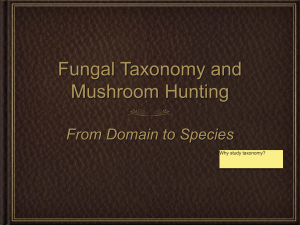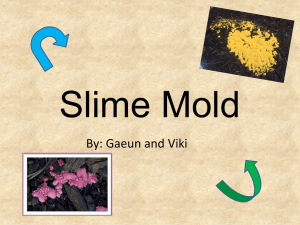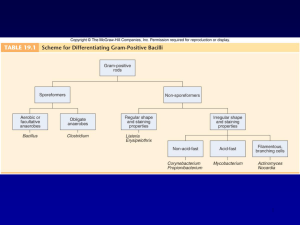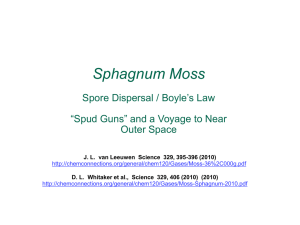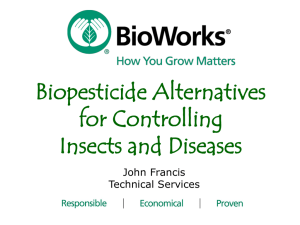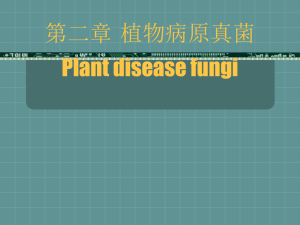Sporulation and Budding
advertisement
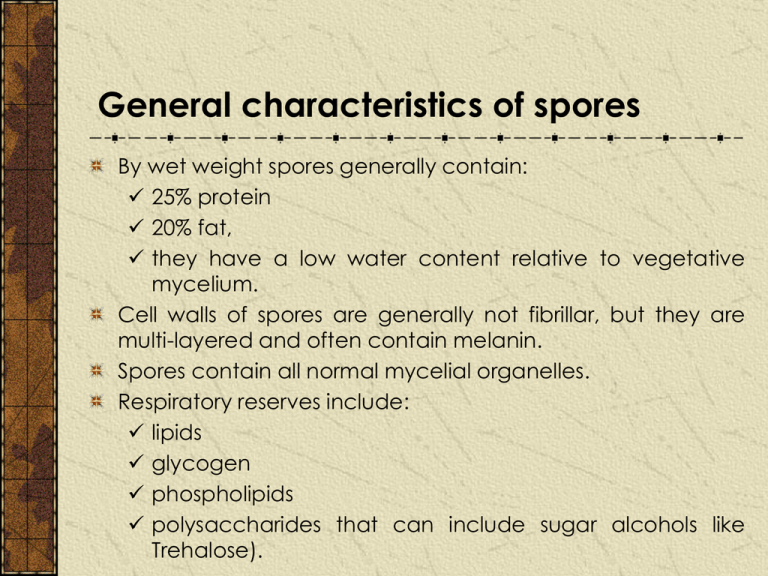
General characteristics of spores By wet weight spores generally contain: 25% protein 20% fat, they have a low water content relative to vegetative mycelium. Cell walls of spores are generally not fibrillar, but they are multi-layered and often contain melanin. Spores contain all normal mycelial organelles. Respiratory reserves include: lipids glycogen phospholipids polysaccharides that can include sugar alcohols like Trehalose). General characteristics of spores Respiration rates in spores are only 1-4% those of vegetative mycelium, but the more reserves a spore has, the longer it will survive. Fungal spores vary in size, shape and colour. Fungal spores may be unicellular or multicellular. For example, conidia produced by Alternaria species are multicellular. While dormant they exhibit a low rate of metabolic activity. They vary in the primary functions they serve, which may including dispersal to a fresh site or host, survival at the same site or increasing genetic variation. They also vary in the methods by which they are formed, released and dispersed. Importance of Fungal Spores Importance: dispersal of reproduction, act as a seed Survival Type of spores: 1)Survival spores 2)Dissemination spores Survival Spores: Formed in response to: Adverse abiotic conditions that can include desiccation, high UV, high/low temperatures or starvation. Biotic factors can also induce sporulation including competition, antagonism, and pathogens presence. These spores have thick cell walls, and lots of reserves. Dissemination spores: Spores that are smaller, with thin cell walls, and limited reserves will germinate readily when on a suitable substrate. Formed as part of the active life cycle of the fungus. often concerned with epidemic spread of a pathogenic species from plant to plant, or with rapid colonization of a substrate. Dormancy Definition – time gap between sporulation and germination (spores do not immediately germinate after formation). Aka “break in the life cycle”. Characteristics – No morphological change seen. Metabolic rate is slower than during vegetative growth. Two types: 1) endogenous (constitutive) 2) exogenous (induced) Types of Dormancy 1) Exogenous Occur because of unfavourable conditions. Ex: no conducive temperature or enough food. 2) Endogenous Dependence on metabolic characteristics and spores structures. Need special conditions to trigger this type of dormancy. Germination of spores can be stopped even when conditions are favourable. Table 1. Endogenous vs Exogenous Dormancy Endogenous dormancy Exogenous dormancy Definite launch mechanism Released by autolysis Small and thin walled spores Large and thick walled Short survival time Survive for a long time Germinate readily under suitable conditions Germinate after a specific stimulus or removal of an inhibitor Factors influencing dormancy 1) 2) 3) 4) Self-stopping spore germination Mycostasis Nutrient storage Wall composition and shape of spores 1) Self-stopping spore germination Dense spore suspension and large number of spores stop spores from germinating. Examples: Uromyces phaseoli (fungus causing rot in beans, sunflower, corn, snapdragon and groundnuts) contain a derivative of cinnamic acid that will stop growth of germ tubes. Puccinia graminis tritici (cause rot in wheat stalks) have germ tubes that grow out of their spore wall. Germination of this fungus is stopped when a complex protein is formed and closed these pores and prevent them from germinating. Conidium of Peronospora tabacina become dormant when a compound called quiesone will stop its protein synthesis. 2) Mycostasis Unsterile soil is able to stop germination of fungal spores and this condition is called mycostasis or fungistasis. 3) Nutrient storage Spore has nutrients stored in their vacuoles. In the conidium of Penicillium, reserved food are kept as polyol. Germination can only occur when there is enough food. Dormant spores have low metabolic rates and this is only enough to sustain life. 4)Wall composition and shape of spores Dormant spores are exposed to unfavorable conditions. Spherical spores give minimal surface exposed to the environment. Melanine which is a black pigment is a component of most spores and not easily degraded by microorganisms. It therefore gives protection to infection by microorganisms and also the penetrating power of the sun’s rays. Types of Dispersal 1) Usage Of Energy Passive Dispersal of Spores: No Own Energy; Use Environment. Active Dispersal of Spores: Use Energy From Fungi. 2) Characteristics of Spores Dry Spores Slimy Spores Wet Spores Combination (1+2) Passive + easily wetted spores Passive + Dry spores Passive + Easily Wetted Spores 1) Stalked Spore Drop Stalk is 50µm – 1 mm long. Transported by insects. Carried by rain water. Can also transport dry and slimy spores. Examples: Sporangia of Dictyostellum and Mucor; Perithecia of Ceratocystis; Conidiophore of Cephalosporum and Graphium. Stalked spores Sporangium of Mucor Synemmata of Graphium spp. Synemmata are bundles of erect hyphae and conidiogenous cells bearing conidia. Passive + Easily Wetted Spores 2) Rain Splash / Drip Splash / Splash Cup Rain wet fungi and slime are diluted. Water droplets carry spores far away. Peridioles are specific names for splash cups and spore sacs in some fungi. Peridioles which are bird’s nest-like are found in Basidiomycetes. Spores can be transported 1 m away through this method. Rain splash / drip splash / splash cup Peridioles of birds nest fungi via air and water Earthstars release their spores in the same way as puffballs. Amongst the other puffball relatives the tough skin of Scleroderma splits to expose the spores to wind and water, allowing the spores to be washed or blown away. Earthstar Scleroderma Via animals Truffles Stickhorn Passive + Dry Spores Dry spores dispersed from spore sacs by :1) Mechanical Action Stream of air form when animal knocks on vegetation and small spores are released. When hot air rises and cold air settles. Hot air carry spores. Rain can also break spore sacs and release spores. Example : Podotaxis have spore sacs containing elaters that change to changes in moisture and thereby further dispersing spores. Passive + Dry Spores 2) Electrostatic Repulsion There are different charges in fungi and leaves. The different charges are results of changes in moisture and infra red rays. If charges are similar for example spores and their spore sacs, they repel each other. Spores are then released. Active Dispersal 1) Turgid Cells Break When asci mature, ascospores are pushed out of asci. There is hydrostatic pressure in asci and ascospores are thrown a few mm away. This will depend on size of ascospores. Example : Neurospora, Pyronema, Sordaria, Claviceps (ASCOMYCETES). Some spores are released with strong vibration. Example : Nigrospora (DEUTEROMYCETES), Pilobus (ZYGOMYCETES). Active Dispersal 2) Change in Cell Shape Spores can be dispersed if shape of sacs changed quickly. Aeciopores of Puccinia are polyhedral in shape (7 faces); absorb water and become spherical; during the change force is produced and throw spores out of sac. Example : Spores of Puccinia. Budding Process Yeasts buds initiated when mother cells attain a critical cell size at a time coinciding with the onset of DNA synthesis Followed by localized weakening of the cell wall together in tension exerted by turgor pressure → allow extrusion of cytoplasm in an area bounded by new cell wall material synthesized by enzymes (glucan & chitin synthases). Chitin, a polymer of Nacetylglucosamine, forms a ring at the junction between the mother cell and the bud. Budding Process (con’t) The chitin ring will eventually form the characteristics bud scar after cell division. Once new daughter bud has initiated, cell surface growth during the remainder of the cell division cycles is restricted to the bud (mother cell wall does not grow very much during budding. ≡ mother and daughter bud are contiguous during bud development) Once mitosis is complete and the bud nucleus and other organelles (ex: mitochondria) have migrated into the bud, cytokinesis ensues and a septum is formed between mother and daughter. Budding Process (con’t) A ring of proteins called septins are involved in positioning cell division. These septins are encircle the neck between mother and daughter for the duration of cell cycle.

